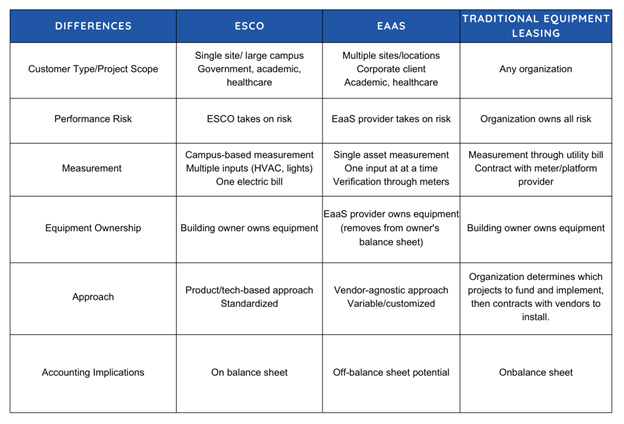Customer Type
Traditional ESCOs generally work only with customers in the municipal and state governments, universities, schools, and hospitals (MUSH Market). EaaS providers, on the other hand, focus on these customer types alongside more corporate customers with large building portfolios. Traditional ESCOs are geared towards large single sites that are suited for implementing multiple types of solutions and measures at once, typically under a long-term deal (25 - 40 years ). These contracts are well suited for entities that tend to stay in one building for a very long time, such as a government customer.
While EaaS providers can work on large complex campuses, they are also more able to scale measures across many buildings. Larger corporations, tend to have real estate assets spread across different geographies and tenants. They are less comfortable or able to commit to long-term contracts. EaaS services are a good fit for corporations because they can be tailored to more complex portfolios and time frames. EaaS can provide uniformity across a distributed real estate portfolio under shorter contract terms (5-20 years). Additionally, an EaaS provider is also equipped to work with companies who lease their buildings out to a third party, and therefore may not have direct access to the energy usage data of their tenant.
Methodology
EaaS and traditional ESCOs also differ on the way they measure savings and guarantee performance. Generally speaking, an ESCO will guarantee savings against your original utility bill, i.e. “Your original bill was X, and we guarantee to reduce it by Y.” To achieve this, the ESCO will implement multiple types of equipment at once (lighting, HVAC, solar). This introduces a lot of variables that must be closely kept track of when reading your utility bill.
While this may work well for a customer with one campus, this approach can introduce unneeded complexity for a customer with many facilities and different needs. In my experience, a lot of companies have a very difficult time deciphering and, frankly, investing the time to try to understand all of these different types of permutations.
The Energy-as-a-Service model takes a more granular asset-level approach to measuring performance. Instead of trying to measure all of the different types of assets within an energy bill, EaaS will implement fewer and more specific types of technology, which allows the customer to only see variables that are relevant to the project at hand. This allows for variable billing where customers pay based on their monthly energy savings.
For companies planning to contract the projects themselves, they’ll need to obtain their own financing using loans, tax credits, and rebates. Additionally, they will need to conduct energy audits to identify projects with the most potential. Then they will need to contract vendors to implement the upgrades. Finally, they will need to work with third-party meters, or review utility bills to try and track the improvements and ROI of their upgrades.
Vendor Relationships
When it comes to choosing the technology or brand of equipment solutions, traditional ESCOs are often locked into a partnership with specific contractors, suppliers, and technology providers. If an equipment provider has an ESCO arm of their business, they will likely only give customers the option to use their specific equipment as the solution.
The EaaS model, on the other hand, tends to be technology and vendor-agnostic. Different buildings and customers require a myriad of different solutions and are spread across a wider geography. This necessitates needing multiple partners in different regions and countries to ensure the work is implemented effectively. What works for one will not work for all.






